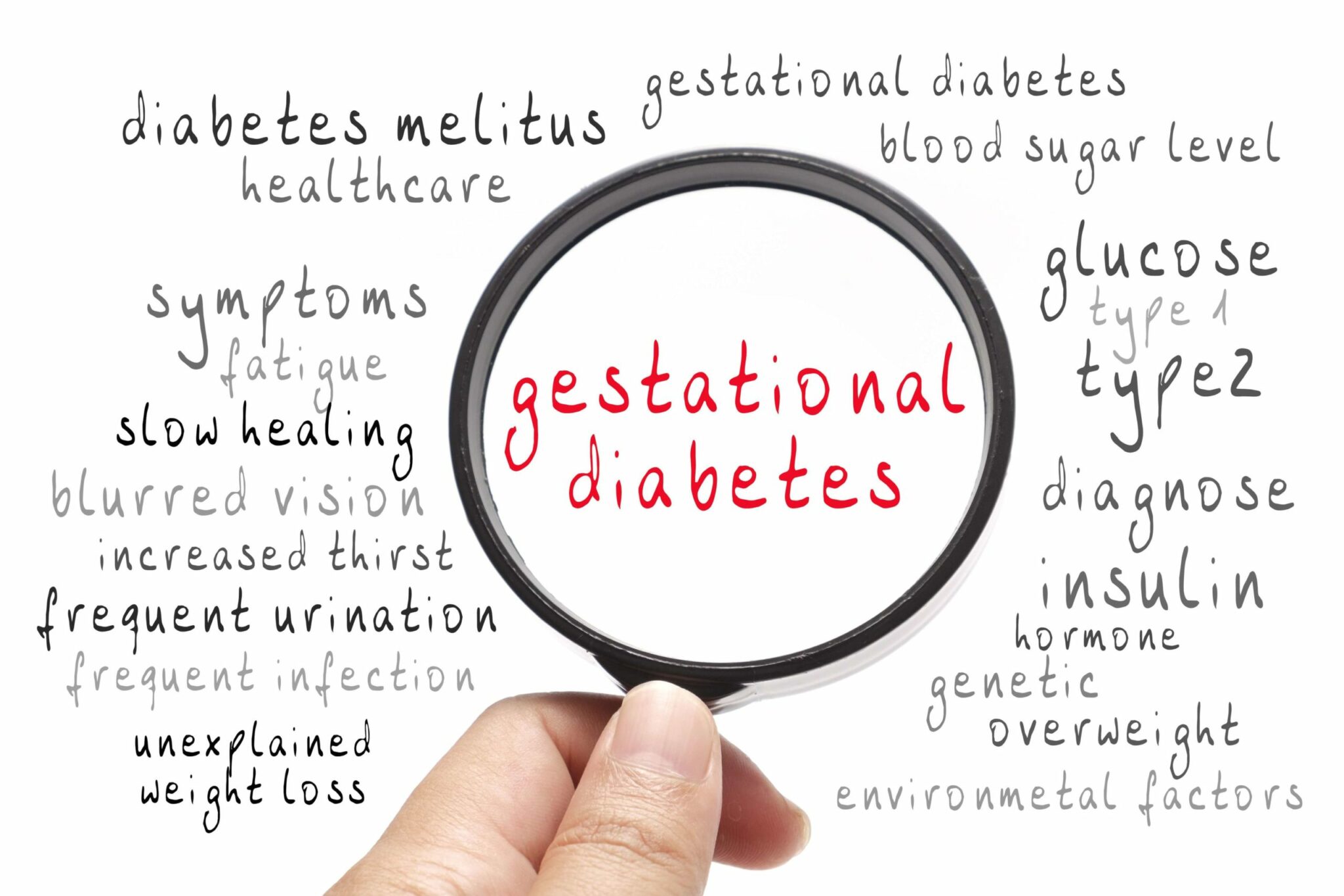Gestational Diabetes: 8 Things you Should Know


Gestational Diabetes Mellitus (GDM) is a form of diabetes that develops during pregnancy. Prevalence rates range from 1% to 15%, depending on the population studied, although, worryingly, one report has shown that over 20% of Qatari women are likely to develop the condition. This highlights the extent of the problem in the MENA region, as both obesity levels and diagnosed cases of type 2 diabetes continue to rise. Fortunately, knowing more about the condition and adopting lifestyle changes can reduce the likelihood of serious complications.
Here are eight things you should know about GDM:
1. Diabetes occurs when you have elevated blood sugar, or glucose.
In diabetes, your body cannot use the sugar and carbohydrates it takes in as food to make energy. As a result, the extra glucose accumulates, causing damage to small blood vessels throughout the body. Parts of the body at risk include the kidneys, the extremities (hands and feet), and sensitive organs, such as the eyes.
2. More than 70% of women with GDM have a BMI > 25.
Approximately half of all cases of GDM are solely attributable to pre-pregnancy obesity and women who are severely obese are 8 times more likely to develop GDM than those who have a Body Mass Index (BMI) within the normal range. Being overweight is considered by many to be the most significant risk factor in the development of GDM. If left untreated, GDM and obesity in combination have a far greater impact on pregnancy outcome, increasing the likelihood of complications during delivery and adverse neonatal effects. Obesity is a modifiable risk factor, which means with the right support and a healthy diet, its detrimental effects can be reduced. This may require visiting a certified nutritionist to ensure you are still getting adequate calories and nutrition, particularly as diet is so important prior to and during pregnancy.
3. Ethnicity is one of the strongest non-modifiable risk factors for developing GDM.
Worldwide the risk of developing GDM during pregnancy is thought to be approximately 10%. However, in certain high risk populations the risk is greater. Different studies have looked at different populations in detail and found that comparing across countries is challenging due to a lack of universally accepted diagnostic criteria and screening approaches. However, there are estimated prevalence rates for various Middle Eastern countries which range from 12.6% in Kuwait to 20.6% in the UAE. The prevalence of GDM amongst Asian Indians is thought to be 19.3%, which is higher than that seen for other Asian sub-populations. The prevalence of GDM across Europe, America and Australia is typically lower, for example, the average pregnant Swedish female has only a 0.4-1.5% risk of GDM.
4. Having a family member with diabetes type 2 increases a woman’s risk of developing GDM.
A study of women with GDM in Qatar, found an overall prevalence rate of 16.3%. Of these women, over 30% had a family history of diabetes. This association is probably due to both genetics and lifestyle factors.
To read about some of the other risk factors for developing GDM click here.
5. Mothers with GDM usually have heavier babies.
Macosomia is the medical term for babies that weigh between 4 and 4.5 KG at birth, they are also referred to as ‘large for gestational age’. A large birth weight is considered to be the predominant consequence of intrauterine exposure to GDM. Macrosomia increases the likelihood of shoulder dystocia and birth injury during delivery. Interventional approaches, such as induction and C-section are sometimes implemented to reduce the risk of macrosomia. Birth weights above 4.5 KG are at significantly greater risk of perinatal and infant mortality.
6. Women with GDM are at increased risk of developing preeclampsia and other pregnancy complications.
Following a GDM diagnosis one of the things your doctor will monitor you particularly closely for is high blood pressure and protein in the urine, as these can be early warning signs of preeclampsia. Preeclampsia is a potentially life-threatening condition that can cause your baby to stop growing and put you at risk of suffering seizures or even a stroke. As a result, if you suspect you have preeclampsia, you should seek medical help immediately and expect to be closely monitored for the remainder of your pregnancy. Other pregnancy complications include polyhydramnios, which occurs when there is an excess of amniotic fluid, and premature delivery (which might be planned or spontaneous).
7. A diagnosis of GDM during pregnancy, increases your risk of being diagnosed with type 2 diabetes after pregnancy.
It is thought that women who experience GDM are up to 7 times more likely to develop type 2 diabetes within the next decade than women who have had a healthy pregnancy. The main reason for this is probably prolonged obesity. Over 70% of women with GDM have an unhealthy BMI (>25), and are classified as overweight, obese or severely obese. Unless they do something about their excess weight, they are likely to remain overweight after delivery. Obese people are estimated to be up to 80 times more likely to develop type 2 diabetes than those who have a BMI in the normal range.
Type 2 diabetes is a chronic condition that requires careful monitoring, diet adjustments and the possibility of taking lifelong medication (insulin).
The risk can be reduced by making the right choices before, during, and after pregnancy. Consume lots of vegetables and whole grains, and have fresh fruit that does not have a high sugar content, such as berries and grapefruit. To prevent excessive weight gain during pregnancy avoid food and drink that has a high sugar content (fizzy drinks, fruit juice, biscuits and most desserts) . Exercising can also help to keep your glucose levels under control. However, if you are not used to undertaking physical activity, consult your doctor prior to beginning any exercise regime.
8. A GDM diagnosis can have long term effects on your child’s health.
Babies who are born to mothers with GDM are at increased risk of becoming overweight or obese during childhood or adolescence. They also have an increased risk of suffering from high blood pressure and impaired glucose tolerance, which, in turn, enhances the likelihood of them going on to develop type 2 diabetes. Recent work has even suggested that changes within the uterine environment can give rise to epigenetic modifications, potentially affecting not just your child, but their offspring and future generations.
The take home message is that, if left untreated, GDM can affect the health of both you and your baby. For the 50% of women who have GDM because they are overweight, implementing a healthy, balanced diet and exercising regularly may well prove sufficient to reduce their BMI to the normal range. This will improve their overall health as well as keeping their blood glucose levels under control and reducing the likelihood of serious complications. If lifestyle adjustments do not sufficiently control your blood sugar levels, your doctor might prescribe medication or insulin to reduce the risk of GDM-related complications affecting you or your unborn baby.
Nabta is reshaping women’s healthcare. We support women with their personal health journeys, from everyday wellbeing to the uniquely female experiences of fertility, pregnancy, and menopause.
Get in touch if you have any questions about this article or any aspect of women’s health. We’re here for you.
Sources:
- Bellamy, L, et al. “Type 2 Diabetes Mellitus after Gestational Diabetes: a Systematic Review and Meta-Analysis.” The Lancet, vol. 373, no. 9677, 23 May 2009, pp. 1773–1779., doi:10.1016/S0140-6736(09)60731-5.
- Bener, A, et al. “Prevalence of Gestational Diabetes and Associated Maternal and Neonatal Complications in a Fast-Developing Community: Global Comparisons.” International Journal of Women’s Health, vol. 3, 2011, pp. 367–373., doi:10.2147/IJWH.S26094.
- “Diabetes and Obesity.” Diabetes.co.uk, www.diabetes.co.uk/diabetes-and-obesity.html.
- “Diabetes in Qatar.” Middle East Forum on Qulity and Safety in Healthcare 2017, www.hamad.qa/EN/All-Events/mefqsh2017/presentations/Documents/Sunday/D6E6_Diabetes.pdf.
- Fadl, H E, et al. “Maternal and Neonatal Outcomes and Time Trends of Gestational Diabetes Mellitus in Sweden from 1991 to 2003.” Diabetic Medicine, vol. 27, no. 4, Apr. 2010, pp. 436–441., doi:10.1111/j.1464-5491.2010.02978.x.
- Groof, Z, et al. “Prevalence, Risk Factors, and Fetomaternal Outcomes of Gestational Diabetes Mellitus in Kuwait: A Cross-Sectional Study.” Journal of Diabetes Research, vol. 2019, no. 9136250, 3 Mar. 2019, doi:10.1155/2019/9136250.
- Mitanchez, D, et al. “Infants Born to Mothers with Gestational Diabetes Mellitus: Mild Neonatal Effects, a Long-Term Threat to Global Health.” The Journal of Pediatrics, vol. 164, no. 3, Mar. 2014, pp. 445–450., doi:10.1016/j.jpeds.2013.10.076.
- Moosazadeh, M, et al. “Family History of Diabetes and the Risk of Gestational Diabetes Mellitus in Iran: A Systematic Review and Meta-Analysis.” Diabetes & Metabolic Syndrome, vol. 11, no. Suppl. 1, Nov. 2017, pp. S99–S104., doi:10.1016/j.dsx.2016.12.016.
- Pu, J, et al. “Racial/Ethnic Differences in Gestational Diabetes Prevalence and Contribution of Common Risk Factors.” Paediatric and Perinatal Epidemiology, vol. 29, no. 5, Sept. 2015, pp. 436–443., doi:10.1111/ppe.12209.
- Schwartz, N, et al. “The Prevalence of Gestational Diabetes Mellitus Recurrence–Effect of Ethnicity and Parity: a Metaanalysis.” American Journal of Obstetrics and Gynecology, vol. 213, no. 3, Sept. 2015, pp. 310–317., doi:10.1016/j.ajog.2015.03.011.
- Yuen, L, and V W Wong. “Gestational Diabetes Mellitus: Challenges for Different Ethnic Groups.” World Journal of Diabetes, vol. 6, no. 8, 25 July 2015, pp. 1024–1032., doi:10.4239/wjd.v6.i8.1024.
With support from Bundoo®










































